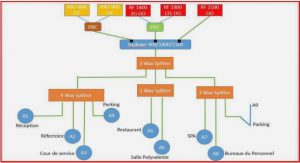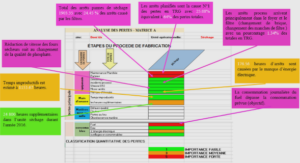Hydrogen and battery loss consumption
Fuel cell
Fuel cell is a generator which produces electricity by the chemical energy. Hydrogen is mostly used as the fuel, sometime, hydrocarbons such as natural gas and alcohols like methanol are also used[l].In 1838, the first fuel cells were invented. A century later, NASA uses the fuel cell to supply the power for probes, satellites and space capsules[2]. From then on, the fuel cell Bbecame widely use in many area, such as: forklifts, automobiles, buses, airplanes, boats, motorcycles and submarines[1][3].Fuel cells have many varieties, such as alkaline fuel cell, phosphoric acid fuel cell, molten carbonate fuel cell, etc. They are made up of three adjacent segments: the anode, the electrolyte and the cathode. Two chemical reactions occur at the interfaces ofthe three different segments. The net result ofthe two reactions is that fuel is consumed and at the same time water and carbon dioxide is produced as byproducts. The main production is electric current[5]
Characteristics
Proton exchange membrane fuel cell has following advantages: The generating process does not involve hydrogen combustion. Thus, it is not limited by the Carnot cycle and improves energy conversion rate. In the process ofpower generating, there is almost « 0 » pollution noise. Generating units is integrated, Therefore, this generating system is modular and high reliability.. At the same time, maintenance and assembly are very convenient. Therefore, this power is a green power which is clean and efficient. Typically, the operating of PEMFC requires a senes of auxiliary equipments which constitutes the generating system. The generating system ofPEMFC consists ofthe stack, hydrogen supply systems, water and heat management systems, power conversion, control systems and other. The stack system is the core of generating systems. PEMFC has sorne obvious advantages such as : low temperature, fast starting, simple structure and easy operating.
Nemo-fuel cell electric vehicIe
Nowadays, vehicle exhausting acts a main part in the » Greenhouse Gas » emission which caused serious affect in the environment. In order to solve these environment problems,the electric vehicles including Hybrid Electric Vehicles (HEV) and Battery Vehicles (BV)[30] gradually replace the internaI engine vehicles. However, the HEV is still indivisible with the oil industry and its future is not optimistic. On the other hand, BV doesn’t act very satisfactory while being compared with the HEV[31] . Summing up the above advantages and disadvantages, Fuel Cell Vehicle becomes the most advantageous candidate because of its zero local, high energy efficiency and fast recharging[32] In order to improve Nemo’ s endurance and solve the problem of its power source, the integrating PEM fuel cell produced by Axane®is equipped in the vehicle. This designing and modification is made in IRH (Institut de recherche sur l’hydrogène).
Utilization of battery series
Nemo uses the 9 series 8V U.S batteries as its power source. This type ofbatteries is the most suitable candidate for the golf cart and multi-propose vehicle. Its feature is fully complying with Nemo ‘s request for carrying the freight or mounting trailer and other applications. In the 8V U.S battery series, there are three productions: 8VGC XC2;8VGCHC XC2 and 8VGCE XC2. Among the three productions, the « US 8VGCHC XC2 » battery is chosen to be installed in Nemo because of its high capacity which can drive Nemo for a longer distance.(parameters are compared in Table 1-3 [35]. Additionally, the 8V series battery has a marvelous performance on its output power which can help the vehicle quickly start and accelerate.
Utilization ofPEMFC
The 48 series PEMFC which produced by Axane® is the energy support of the Nemo truck and they are used to charge the battery. Therefore, the energy exchanging between fuel cell and battery is the pure electrical energy conversion. Axane® designed and made fuel cells for different uses, such as emergency backup generators. For example, it can be used when the power grid is not reliable or if it becomes unavailable[37].
|
Table des matières
Summary
Résumé
Acknowledgements
Tables List
Figures List
List of Symbols
Chapter 1 – Introduction
1.1 Fuel cell
1. 1.1 Classification and characteristics
1. 1.2 PEMFC
1.1.3 Electric vehicle
1.2 Introduction ofthe devices
1.2.1 Nemo-fuel cell electric vehicle
1.2.2 Basic principles ofthe Nemo
1.2.3 Utilization ofbattery series
1.2.4 Utilization ofPEMFC
1.3 Chapter summary
Chapter 2 – CUITent Situation and Expected Optimization
2.1 Existing optimization
2.1 . 1 Energy management offuel cell
2.1.2 Energy management ofbattery
2.2 Objective and expected optimization – Energy management ofcharging system
2.2 . 1 Flow chart ofNemo truck
2.2.2 Battery status
2.2.3 Cycles ofbattery charging
2.2.4 Aging cost offuel cell system
2.2.5 Cost ofbattery
2.2.6 Present hydrogen consumption offuel cell
2.2.7 Cost economization
2.3 Chapter summary
Chapter 3 – Simulation
3.1 Basic model ofNemo truck
3.2 Physics and mathematics models ofthe Nemo
3 .2.1 Dynamic model
3.2.2 Power demand
3.3 Voltage distribution offuel Cell
3.3.1 Nernst equation
3.3 .2 Activation
3.3.3 Ohmic over-potential
3.3.4 Concentration over-potential
3.4 Hydrogen consumption
3.5 Battery state
3.5.1 Power transferring among fuel cell, battery and motor
3.5.2 Charging-discharging circuit
3.6 Chapter summary
Chapter 4 – Optimization ofthe Nemo truck
4.1 Hydrogen and battery loss consumption
4.2 Starting time optimization ofthe fuel cell
4.3 Optimization ofthe circuit
4.3 . 1 Monitoring and controlling ofthe SOC
4.4 Further modified circuit
4.5 New charging circuit with variable resistor
4 .6 Chapter summary
Chapter 5-Discussion of the results observed
5.1Conclusions and discussion
5.2 Prospects and future work
References
Chapter 6 – Appendix A- Résumé du travail de recherché
6.1 Introduction
6. 1.1 Travaux existants
6.2 Modélisation de Nemo
6.2. 1 Modèle dynamique
6.2.2 Modèle du fuel cell
6.2.3 État de la batterie
6.2.4 Consommation d’hydrogène
6.3 Optimisation de la Nemo
6.3.1 L’optimisation des temps de départ
6.3.2 Optimisation du circuiT
6.3.3 Poursuite de l’optimisation de la résistance de charge
6.3.4 Caculation de l’optimisation des ecnomy
6.4 Conclusion
Appendix B Technical Specifications Manufacturer
Appendix C Simulation Code in Matlab
![]() Télécharger le rapport complet
Télécharger le rapport complet






